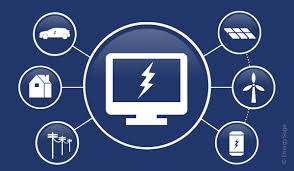
Microgrid
From Wikipedia
A microgrid is a localized group of electricity sources and loads that normally operates connected to and synchronous with the traditional wide area synchronous grid (macrogrid), but can also disconnect to “island mode” — and function autonomously as physical or economic conditions dictate.
In this way, a microgrid can effectively integrate various sources of distributed generation (DG), especially Renewable Energy Sources (RES) – renewable electricity, and can supply emergency power, changing between island and connected modes.
Control and protection are challenges to microgrids. A very important feature is also to provide multiple end-use needs as heating, cooling, and electricity at the same time since this allows energy carrier substitution and increased energy efficiency due to waste heat utilization for heating, domestic hot water, and cooling purposes (cross sectoral energy usage).
Definition
The United States Department of Energy Microgrid Exchange Group defines a microgrid as a group of interconnected loads and distributed energy resources (DERs) within clearly defined electrical boundaries that acts as a single controllable entity with respect to the grid. A microgrid can connect and disconnect from the grid to enable it to operate in both connected or island-mode.
The EU research project describes a microgrid as comprising Low-Voltage (LV) distribution systems with distributed energy resources (DERs) (microturbines, fuel cells, photovoltaics (PV), etc.), storage devices (batteries, flywheels) energy storage system and flexible loads. Such systems can operate either connected or disconnected from the main grid. The operation of microsources in the network can provide benefits to the overall system performance, if managed and coordinated efficiently.
Types of microgrids
A typical scheme of an electric based microgrid with renewable energy resources in grid-connected mode
Campus Environment/Institutional Microgrids
The focus of campus microgrids is aggregating existing on-site generation with multiple loads located in tight geography in which owner easily manage them.
Community Microgrids
Community Microgrids can serve up to a few thousands of customers and support the penetration of local energy (electricity, heating, and cooling). In a community microgrid, some houses may have some renewable sources that can supply their demand as well as that of their neighbors within the same community. The community microgrid may also have a centralized or several distributed energy storage. Such microgrids can be in the form of an ac and dc microgrid coupled together through a bi-directional power electronic converter.
Remote Off-grid Microgrids
These microgrids never connect to the Macrogrid and instead operate in an island mode at all times because of economic issues or geographical position. Typically, an “off-grid” microgrid is built in areas that are far distant from any transmission and distribution infrastructure and, therefore, have no connection to the utility grid. Studies have demonstrated that operating a remote area or islands’ off-grid microgrids, that are dominated by renewable sources, will reduce the levelized cost of electricity production over the life of such microgrid projects.
Large remote areas may be supplied by several independent microgrids, each with a different owner (operator). Although such microgrids are traditionally designed to be energy self-sufficient, intermittent renewable sources and their unexpected and sharp variations can cause unexpected power shortfall or excessive generation in those microgrids. This will immediately cause unacceptable voltage or frequency deviation in the microgrids. To remedy such situations, it is possible to interconnect such microgrids provisionally to a suitable neighboring microgrid to exchange power and improve the voltage and frequency deviations. This can be achieved through a power electronics-based switch after a proper synchronization or a back to back connection of two power electronic converters] and after confirming the stability of the new system. The determination of a need to interconnect neighboring microgrids and finding the suitable microgrid to couple with can be achieved through optimization[19] or decision making[20] approaches.
Military Base Microgrids
These microgrids are being actively deployed with focus on both physical and cyber security for military facilities in order to assure reliable power without relying on the Macrogrid.
Commercial and Industrial (C&I) Microgrids
These types of microgrids are maturing quickly in North America and Asia Pacific; however, the lack of well –known standards for these types of microgrids limits them globally. Main reasons for the installation of an industrial microgrid are power supply security and its reliability. There are many manufacturing processes in which an interruption of the power supply may cause high revenue losses and long start-up time. Industrial microgrids can be designed to supply circular economy (near-)zero-emission industrial processes, and can integrate combined heat and power (CHP) generation, being fed by both renewable sources and waste processing; energy storage can be additionally used to optimize the operations of these sub-systems.]



